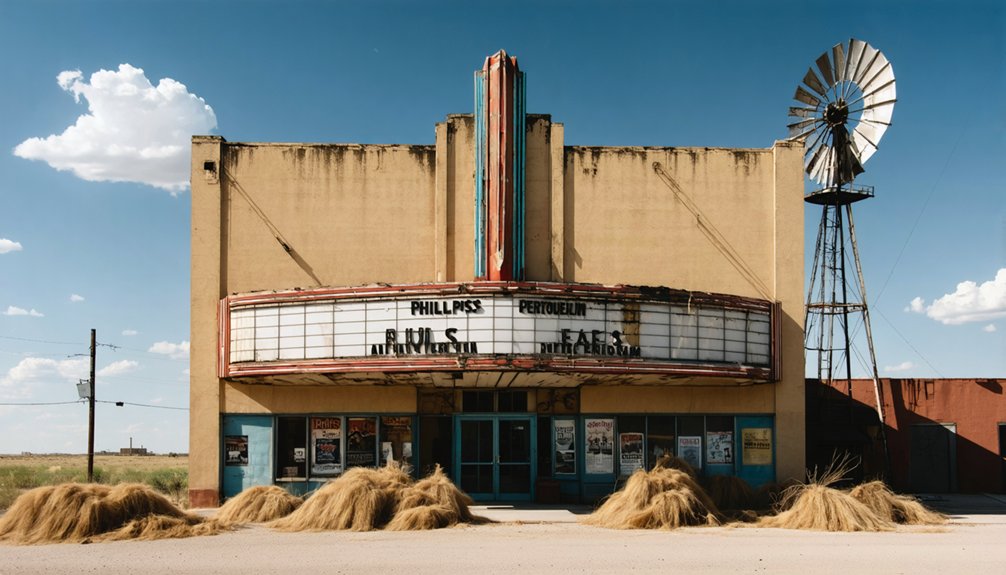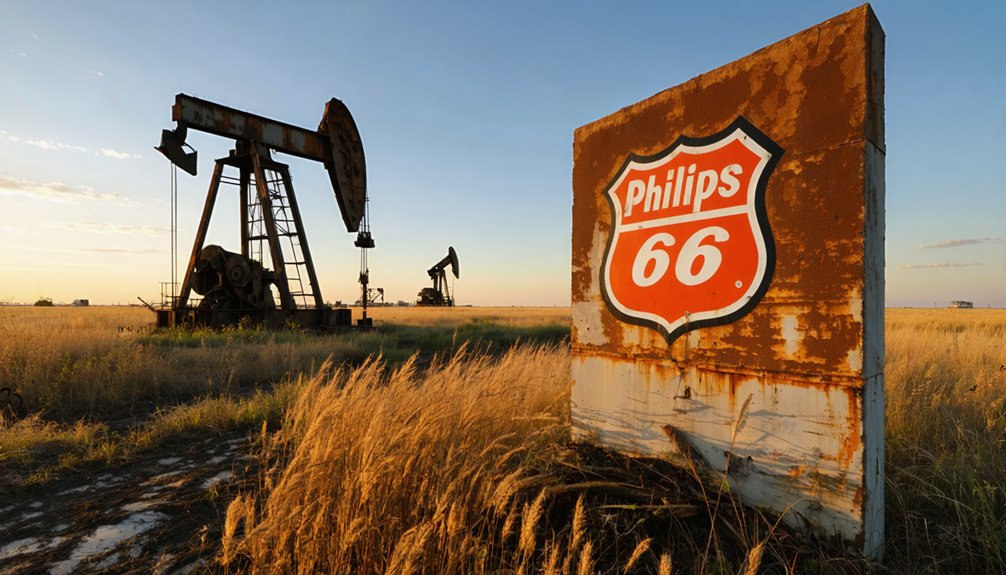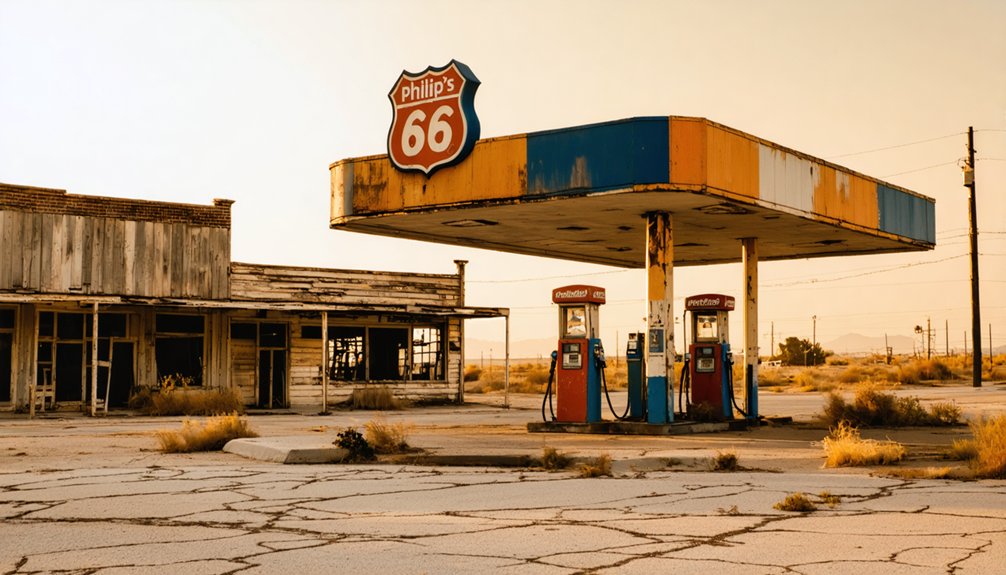You’ll find Phillips, Texas, about 50 miles northeast of Amarillo, where a thriving oil town once stood. After Phillips Petroleum Company built the Alamo Refinery in 1927, the community grew to 4,000 residents with schools, churches, and legendary sports teams. A devastating refinery explosion in 1980 marked the beginning of the end, and by 1990, the town had completely vanished. Yet beneath the empty Texas plains, a rich history of community spirit and industrial innovation awaits.
Key Takeaways
- Phillips was a thriving company town built by Phillips Petroleum Company in Texas during the 1920s oil boom, reaching 4,000 residents.
- The town featured company-provided housing, schools, churches, and a downtown district centered around the Alamo Refinery operations.
- Phillips High School’s Blackhawks football team achieved legendary status with 172 wins and a 1954 state championship.
- A devastating refinery explosion in 1980 triggered the town’s decline, leading to widespread relocation of residents.
- By 1990, Phillips completely disappeared from maps, though its legacy lives on through alumni reunions and commemorative events.
The Oil Boom Origins and Early Settlement
When the oil boom erupted in Borger, Texas in 1926, it transformed the Texas Panhandle into a bustling frontier that drew over 30,000 people seeking their fortune.
You’d have found yourself among transient workers living in makeshift housing, traversing dirt roads plagued by potholes and seasonal dust storms. The nearby town of Phillips emerged in the 1930s as a significant service hub for the growing oil field operations.
As the initial frenzy settled, you’d have witnessed the shift from a rough-and-tumble boomtown to a more stable community. The town’s identity grew stronger with the establishment of Baptist and Methodist churches that became cornerstones of local life.
Oil field workers began bringing their families, trading temporary lodging for modest “shotgun” homes – three-room structures built in a straight line.
The Phillips Petroleum Company‘s influence shaped the region’s development, providing steady employment and controlling much of the surrounding land. The town reached its peak when the population hit 4,000 by 1947.
Rise of a Company Town: 1926-1950
As you explore Phillips’ early growth, you’ll find that Phillips Petroleum Company’s 1927 establishment of the Alamo Refinery transformed two competing settlements, Pantex and Whittenburg, into a unified company town by 1938.
The company invested heavily in community infrastructure, including a $77,000 school and housing for teachers, creating a stable environment that attracted families rather than the transient workers typical of oil boomtowns. Following common practices of the era, rental homes were provided to employees at modest rates to ensure workforce stability.
Like many company towns in Texas, Phillips developed well-ordered amenities that included stores, recreational facilities, and essential services for its residents.
Oil Discovery Sparks Growth
The discovery of major oil fields in the Permian Basin during the 1920s transformed Phillips, Texas from empty plains into a bustling company town. You’d have witnessed the dramatic changes as Phillips Petroleum Company established its first Texas refinery in nearby Borger in 1927, sparking rapid oil production and community development throughout the region.
The company’s strategic move coincided with the Permian Basin’s emergence as a leading U.S. oil producer. As workers flocked to the area, Phillips built housing, infrastructure, and amenities to support its growing workforce. The newly formed Phillips 66 trademark in 1930 became a prominent symbol of the company’s growing influence in the region. Like the discovery of the East Texas Field in October 1930, this period marked significant expansion in Texas oil production.
You’d have seen company-sponsored facilities spring up alongside the refinery operations, creating a tight-knit community where employees and their families could thrive. The town’s identity became inseparable from the petroleum industry that gave it life, mirroring similar transformations across Texas’s oil-rich territories.
Company Housing Builds Community
Building a thriving community from scratch required more than just a refinery – it demanded homes, schools, and gathering places where workers could put down roots.
Starting in 1927, Phillips Petroleum invested heavily in housing stability, constructing two-bedroom and shotgun-style homes equipped with modern amenities like electricity and running water. Like their future subsidiary Chevron Phillips Chemical, the company demonstrated a strong commitment to developing sustainable communities.
You’d find everything you needed within walking distance – grocery stores, barbershops, cleaners, and a post office. The company’s $77,000 investment in a school showed their commitment to community cohesion, while recreational facilities like a swimming pool, baseball stadium, and golf course gave families places to gather and connect.
Community Life and Local Landmarks
If you’d visited Phillips’ downtown during its heyday, you’d have found a bustling business district with essential services like Jolly Drug, 66 Cleaners, and Ostrum Grocery serving the community’s daily needs.
The spiritual heart of Phillips centered around its Baptist and Methodist churches, which anchored the town’s religious life throughout the 1950s.
Local gatherings and commerce created a tight-knit social fabric that defined Phillips as more than just a company town, though this vibrant community life would eventually dissolve following the catastrophic 1980 refinery explosion. After the explosion, many residents relocated as homes were moved to Borger and other nearby towns.
Downtown Business District
During its heyday, Phillips’ downtown business district served as the economic heartbeat of this company town, where oil industry workers and their families found everything they needed for daily life.
You would’ve seen a typical grid-pattern layout with downtown architecture reflecting the mid-20th century style common in small American towns. Like McLean, Texas, the area experienced significant growth during the 1927 oil boom. While specific business diversity details aren’t extensively documented, you’d have found the essential establishments that kept the community running – general stores, gas stations, and local diners where workers gathered. Similar to many towns along historic highways, interstate construction diverted traffic and contributed to the area’s economic decline.
The streets bustled with activity until 1980, when a devastating hydrocarbon explosion marked the beginning of the end. As Phillips Petroleum Company scaled back operations, downtown businesses gradually shuttered their doors, and the once-vibrant district faded into history.
Churches and Social Gatherings
Beyond the bustling storefronts of downtown Phillips, the town’s religious and social life centered around its Baptist and Methodist churches in the 1950s.
These churches weren’t just places of worship – they served as anchors of community identity, hosting everything from Sunday services to weddings and holiday celebrations.
You’d find residents gathering regularly for church gatherings that strengthened social bonds beyond family ties.
While the churches fostered spiritual connections, Phillips High School football games emerged as another powerful force uniting the community.
School events, from plays to graduations, drew crowds together despite unpaved roads.
The devastating 1980 refinery explosion changed everything, damaging church buildings and accelerating the town’s decline.
As residents relocated, congregations dissolved, ending organized religious life in Phillips.
Today, only memories remain, preserved through alumni reunions and oral histories.
The Glory Days: Sports and Social Scene
While many small Texas towns lived and died by their high school football programs, Phillips distinguished itself as a true sports powerhouse through its legendary Blackhawks football team.
You couldn’t miss the sports nostalgia that defined this tight-knit community, especially when the Blackhawks racked up an astounding 172 wins against just 23 losses, including their crowning achievement – the 1954 state championship.
The community spirit soared highest during game days, when you’d find the whole town gathered at the field, from the regulars at Jolly Drug to the folks who’d just finished their shift at the refinery.
Sports weren’t just games in Phillips – they were the heartbeat of social life, bringing everyone together at a time when the oil boom had transformed this Panhandle town into a thriving community.
Economic Challenges and Population Decline

The athletic glory of Phillips, Texas masked a deeper economic vulnerability that would eventually spell the town’s downfall. Founded in 1938, the town’s economic resilience depended almost entirely on Phillips Petroleum Company, leaving it susceptible to industry fluctuations.
You’d have seen a bustling community of 4,000 residents by 1947, but dramatic demographic shifts would soon follow.
As highways improved in the 1950s and ’60s, businesses started relocating to nearby Borger. The town’s fate was further sealed when Phillips Petroleum began expanding its refinery operations, offering incentives for residents to move away.
The Final Chapter: Legal Battles and Exodus
Legal battles erupted in Phillips during the 1960s as residents fought desperately to save their community from corporate displacement. The town’s legal entanglements centered on Phillips Petroleum Company‘s dominance over land and mineral rights, leading to complex disputes over property ownership and drilling operations.
You’ll find records of fierce community resistance, including the hiring of renowned attorney F. Lee Bailey to fight eviction threats through legal injunctions.
Despite these efforts, the town’s fate was sealed. The uncertainty of land rights and corporate pressure triggered a mass exodus, with the population plummeting from 4,105 in 1950 to zero by 1990.
As homes were physically relocated and families departed, Phillips transformed from a thriving oil town into a stark reminder of corporate power‘s impact on small communities.
Modern Legacy and Historical Impact

Although Phillips physically vanished from Texas maps by 1990, its legacy endures through an active alumni association and strong community bonds that transcend geographical boundaries.
You’ll find the town’s spirit alive in reunions where former residents share memories of the once-thriving community of 4,250 people. The Phillips Blackhawks’ athletic achievements, including their legendary 172-23 football record and 1954 state championship, remain a source of pride in community memory.
While the old high school building stands behind refinery gates as one of the few remaining structures, alumni nostalgia keeps Phillips’ cultural identity vibrant through social media, websites, and commemorative events.
Despite economic shifts and the devastating 1980 explosion that accelerated its decline, Phillips’ impact on Texas history remains indelible.
Frequently Asked Questions
What Happened to the Displaced Residents’ Jobs at Phillips Petroleum Company?
You’ll find it striking that right when Phillips Petroleum closed, workers faced tough job changes, relocating to Borger or other oil towns, causing devastating economic impact on their families.
Were There Any Environmental Concerns That Contributed to the Town’s Closure?
You’ll find that environmental impact from the refinery explosion and ongoing pollution concerns about living near an industrial complex were key factors justifying Phillips’ closure, though some dispute these official safety reasons.
How Much Did Phillips Petroleum Company Pay Homeowners for Their Properties?
Like a vanishing footprint in history’s sand, you
Did Any Original Phillips Buildings Survive by Being Relocated to Nearby Towns?
Yes, you’ll find many original Phillips homes preserved in Stinnett, Fritch, and Borger, where they were relocated. Despite losing their historical context, these buildings maintain their significance as remnants of Phillips’ legacy.
What Natural Disasters or Significant Accidents Occurred During Phillips’ 64-Year History?
You’d shudder at Phillips’ turbulent history – the devastating school fire, countless refinery explosions rattling windows, and the catastrophic 1980 hydrocarbon blast that ultimately sealed the town’s fate and forced residents out.
References
- https://lonestargridiron.com/2018/05/phillips-texas-the-ghost-of-a-football-powerhouse/
- https://www.legendsofamerica.com/tx-hutchinsonghosttowns/
- https://thebullamarillo.com/what-happened-to-the-town-of-phillips-texas/
- https://mix941kmxj.com/what-really-made-phillips-tx-suddenly-disappear/
- https://www.hppr.org/hppr-people-communities/2017-07-16/phillips-texas-a-remembrance
- https://tylerpaper.com/2018/02/28/womans-book-recalls-growing-up-in-phillips-before-it-was-a-ghost-town/
- https://www.texasescapes.com/TexasPanhandleTowns/Phillips-Texas.htm
- https://www.tshaonline.org/handbook/entries/phillips-tx
- https://mksconbrio.com/art/boomtown-texas/
- https://www.youtube.com/watch?v=-N0Mt-PFycI



